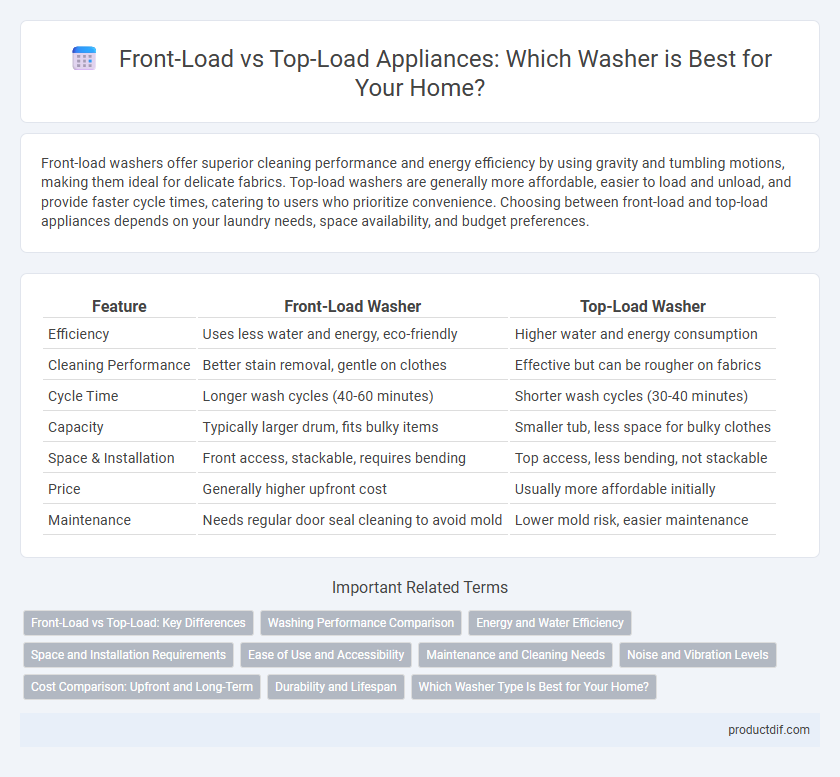Front-load washers offer superior cleaning performance and energy efficiency by using gravity and tumbling motions, making them ideal for delicate fabrics. Top-load washers are generally more affordable, easier to load and unload, and provide faster cycle times, catering to users who prioritize convenience. Choosing between front-load and top-load appliances depends on your laundry needs, space availability, and budget preferences.
Table of Comparison
| Feature | Front-Load Washer | Top-Load Washer |
|---|---|---|
| Efficiency | Uses less water and energy, eco-friendly | Higher water and energy consumption |
| Cleaning Performance | Better stain removal, gentle on clothes | Effective but can be rougher on fabrics |
| Cycle Time | Longer wash cycles (40-60 minutes) | Shorter wash cycles (30-40 minutes) |
| Capacity | Typically larger drum, fits bulky items | Smaller tub, less space for bulky clothes |
| Space & Installation | Front access, stackable, requires bending | Top access, less bending, not stackable |
| Price | Generally higher upfront cost | Usually more affordable initially |
| Maintenance | Needs regular door seal cleaning to avoid mold | Lower mold risk, easier maintenance |
Front-Load vs Top-Load: Key Differences
Front-load washers typically offer better water and energy efficiency compared to top-load models, using less detergent and providing gentler fabric care. Top-load washers often feature faster cycle times and easier loading for users who prefer not to bend, while front-loaders excel in spin speeds that extract more water, reducing drying time. Maintenance differs as front-loaders require door seals and gasket care to prevent mold, whereas top-loaders generally have simpler upkeep and fewer odor issues.
Washing Performance Comparison
Front-load washers deliver superior washing performance by using tumbling and gravity to gently yet effectively remove dirt and stains, achieving higher Spin Speeds up to 1,200 RPM for enhanced water extraction and shorter drying times. Top-load washers typically operate with an agitator or impeller that provides quicker wash cycles but may be less efficient at cleaning heavily soiled clothes and can be harsher on fabrics. Energy Star-rated front-load models consistently outperform top-load units in water and energy consumption, making them a preferred choice for deep cleaning and sustainability.
Energy and Water Efficiency
Front-load washing machines deliver superior energy efficiency by using less electricity compared to top-load models, often consuming up to 40% less energy per cycle. They utilize a tumbling action that requires significantly less water, reducing water usage by approximately 30%-50%. These combined efficiencies make front-load washers a preferred choice for eco-conscious consumers aiming to minimize utility costs and environmental impact.
Space and Installation Requirements
Front-load washers require less floor space due to their horizontal drum orientation, making them ideal for smaller laundry areas or stacked installation. Top-load washers need more vertical clearance for the lid to open fully and often require extra space around the machine for water hose connections. Proper installation of front-load models typically demands level flooring to prevent vibration, while top-load models are more tolerant of uneven surfaces.
Ease of Use and Accessibility
Front-load washers offer greater ease of use with a convenient waist-level door that reduces bending, making them accessible for users with mobility challenges. Top-load washers provide quicker access during cycles and allow users to add clothes mid-wash, enhancing operational flexibility. Both designs cater to different ergonomic needs, but front-load models are often preferred for their user-friendly control placement and reduced physical strain.
Maintenance and Cleaning Needs
Front-load washers require regular gasket cleaning and door seal maintenance to prevent mold and mildew buildup, ensuring optimal machine hygiene. Top-load washers often need less frequent drum cleaning but benefit from periodic agitator inspections and lint trap removal for efficient operation. Both types demand routine detergent dispenser cleaning to avoid residue accumulation and maintain washing performance.
Noise and Vibration Levels
Front-load washers generally produce lower noise and vibration levels compared to top-load models due to their horizontal drum design and advanced suspension systems. Top-load washers often generate more noise and vibration, especially during the spin cycle, because their vertical drum movement causes greater mechanical stress. Modern front-load appliances incorporate noise-reduction technologies, making them ideal for households prioritizing quiet operation.
Cost Comparison: Upfront and Long-Term
Front-load washers typically have a higher upfront cost, ranging from $700 to $1,400, compared to top-load washers that cost between $400 and $900. Long-term expenses favor front-load models due to their energy and water efficiency, resulting in savings of up to 25% on utility bills over time. Maintenance costs may be slightly higher for front-load washers due to complex parts, but the overall cost-effectiveness often offsets the initial investment.
Durability and Lifespan
Front-load washing machines generally offer greater durability due to their advanced engineering and fewer moving parts that cause wear over time, often lasting 10-15 years with proper maintenance. Top-load washers, while typically less expensive, experience more mechanical stress from agitators or impellers, which can reduce their average lifespan to around 8-12 years. Consumers seeking long-term reliability and reduced repair frequency often prefer front-load models for their robust construction and efficient performance.
Which Washer Type Is Best for Your Home?
Front-load washers offer superior energy efficiency and gentle fabric care, making them ideal for homes prioritizing sustainability and delicate laundry needs. Top-load washers provide faster wash cycles and easier loading, suitable for households seeking convenience and quick turnaround. Choosing the best washer depends on laundry volume, space constraints, and specific fabric care preferences.
Front-Load vs Top-Load Infographic

 productdif.com
productdif.com